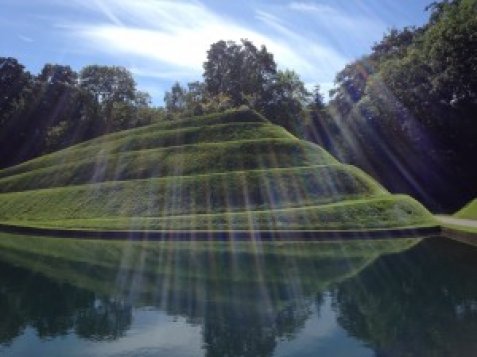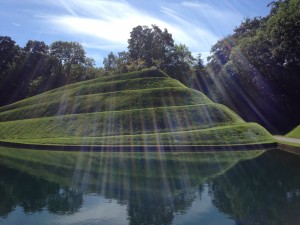
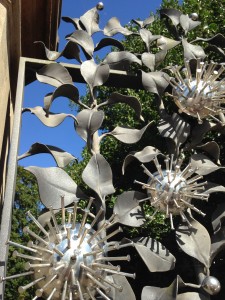 Visitors to the Edinburgh Festival and its cuckoo offspring, the Fringe, will find themselves beetling about from venue to venue in a mad rush to fit everything in. In the frantic scurry-about, wearing down shoe-leather, the beauty of Edinburgh’s setting and architecture seeps into the soul. This year we decided to take in landscapes as well: Arthurs Seat, Isle of Inchcolm and Jupiter Artland. The last one for the all the fresh news coverage in the wake of Museum of the Year award. We bussed out of Edinburgh along a street lined with supermarkets of the world and were eventually set down at the dusty yard of an agricultural wholesaler with a caravan selling butties and Ironbru. The locals pointed us back up the road. There had been a bus-stop “vandalised and burnt down” the man in pink told us.
Visitors to the Edinburgh Festival and its cuckoo offspring, the Fringe, will find themselves beetling about from venue to venue in a mad rush to fit everything in. In the frantic scurry-about, wearing down shoe-leather, the beauty of Edinburgh’s setting and architecture seeps into the soul. This year we decided to take in landscapes as well: Arthurs Seat, Isle of Inchcolm and Jupiter Artland. The last one for the all the fresh news coverage in the wake of Museum of the Year award. We bussed out of Edinburgh along a street lined with supermarkets of the world and were eventually set down at the dusty yard of an agricultural wholesaler with a caravan selling butties and Ironbru. The locals pointed us back up the road. There had been a bus-stop “vandalised and burnt down” the man in pink told us.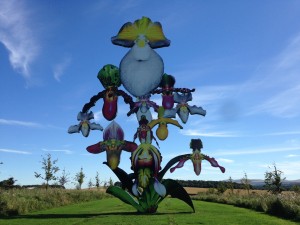 The gates to the estate gleam - a clever construction of metal sunflowers. From sturdy sockets sprout nails as petals. Footpaths meander through a wood and we followed a trail past trees with Jews ear fungus and thickets of brambles. Round a corner Cells of Life by Charles Jencks comes into view. The remit of this sculpture park is to educate and to promote artists who choose where to put their commission and respond to the site by creating what suits. Cells of Life is a crowd pleaser with coils of raised earth swirling up into tumuli and lapped by basking ponds of still water. The installation made me uneasy. For a long time I have had designs on Jenck’s Garden of Cosmic Speculation but it is only open for one day per annum. Instead I have visited the lesser coiling mound garden at Scotland’s National Gallery of Modern Art. No doubt the Cosmic Speculation one is vast and therefore awe inspiring. These other two leave me wondering about the exacting maintenance implications and whisper a thought that Jencks has had a good idea and is exporting it as a branded product. The mounds at Jupiter seem to fight with the view of the Pentland Hills and it is depressing too to see the heap of spoil dumped unceremoniously beyond the carpark. As for H&S, the lifesaver is mounted neatly at a distance which will not save anyone.
The gates to the estate gleam - a clever construction of metal sunflowers. From sturdy sockets sprout nails as petals. Footpaths meander through a wood and we followed a trail past trees with Jews ear fungus and thickets of brambles. Round a corner Cells of Life by Charles Jencks comes into view. The remit of this sculpture park is to educate and to promote artists who choose where to put their commission and respond to the site by creating what suits. Cells of Life is a crowd pleaser with coils of raised earth swirling up into tumuli and lapped by basking ponds of still water. The installation made me uneasy. For a long time I have had designs on Jenck’s Garden of Cosmic Speculation but it is only open for one day per annum. Instead I have visited the lesser coiling mound garden at Scotland’s National Gallery of Modern Art. No doubt the Cosmic Speculation one is vast and therefore awe inspiring. These other two leave me wondering about the exacting maintenance implications and whisper a thought that Jencks has had a good idea and is exporting it as a branded product. The mounds at Jupiter seem to fight with the view of the Pentland Hills and it is depressing too to see the heap of spoil dumped unceremoniously beyond the carpark. As for H&S, the lifesaver is mounted neatly at a distance which will not save anyone. 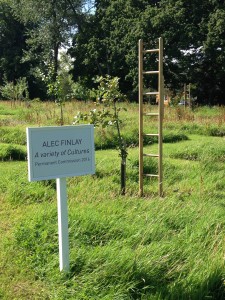 Site specific art? A visit to Roche Court in Hampshire will demonstrate the pure artistry of installations well placed in the lovely bowl of a valley - rivers of slate by Richard Long trickling down a hill, courtyards of calligraphy and Gormley jugglers etched against beech wood backdrop. The Cass Foundation near Goodwood balances the same excellence of artworks, conceptual and figurative embracing their setting. Less so here. Jencks pokes two fingers at the undulating wide view of farmland, hills and large sky. So to does the Giant work of Irises on panels which positively growls at its surroundings. The added distraction is of trees wilting and neglected for lack of water. A couple more installations seem less than fit for site. First, beehives, (by Ian Hamilton Finlay and not translating from the continual word patter jokey-ness that flows at Little Sparta) artfully inscribed but bee-less. Second, an orchard with ladder installations - where the wood will rot years before the trees reach picking size. We could see a Schonbrun yellow house of considerable loveliness beyond a ha-ha but by now felt out of sorts and ready for that cold tin of Iron-bru. We turned tail and fled. I blame Dan Pearson for a lecture I went to and his book “Spirit: Garden Inspiration.” Here this was sadly lacking.
Site specific art? A visit to Roche Court in Hampshire will demonstrate the pure artistry of installations well placed in the lovely bowl of a valley - rivers of slate by Richard Long trickling down a hill, courtyards of calligraphy and Gormley jugglers etched against beech wood backdrop. The Cass Foundation near Goodwood balances the same excellence of artworks, conceptual and figurative embracing their setting. Less so here. Jencks pokes two fingers at the undulating wide view of farmland, hills and large sky. So to does the Giant work of Irises on panels which positively growls at its surroundings. The added distraction is of trees wilting and neglected for lack of water. A couple more installations seem less than fit for site. First, beehives, (by Ian Hamilton Finlay and not translating from the continual word patter jokey-ness that flows at Little Sparta) artfully inscribed but bee-less. Second, an orchard with ladder installations - where the wood will rot years before the trees reach picking size. We could see a Schonbrun yellow house of considerable loveliness beyond a ha-ha but by now felt out of sorts and ready for that cold tin of Iron-bru. We turned tail and fled. I blame Dan Pearson for a lecture I went to and his book “Spirit: Garden Inspiration.” Here this was sadly lacking. 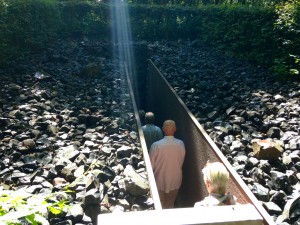 On our way out we encountered a grotto descending into the bowels of the earth. We trudged down, aliens descending from a space-ship. The work is by Anya Gallacio. I say let sleeping landscapes lie. This is Jupiter Arltland seen through the lens of a gardener obsessing over genius loci. As a means of introducing children to contemporary art, a visit will be a source of eye-popping wonder.
On our way out we encountered a grotto descending into the bowels of the earth. We trudged down, aliens descending from a space-ship. The work is by Anya Gallacio. I say let sleeping landscapes lie. This is Jupiter Arltland seen through the lens of a gardener obsessing over genius loci. As a means of introducing children to contemporary art, a visit will be a source of eye-popping wonder.
